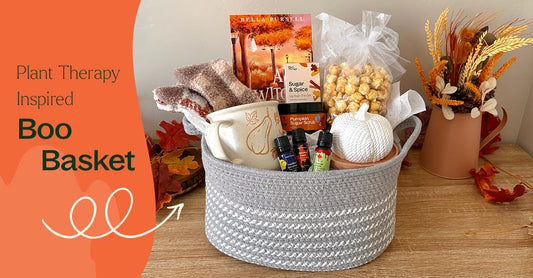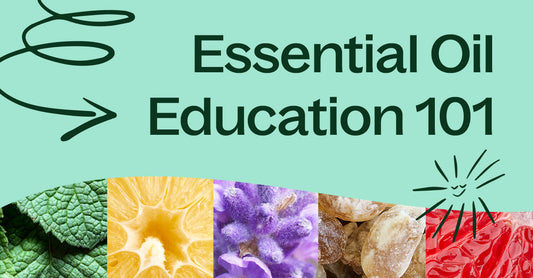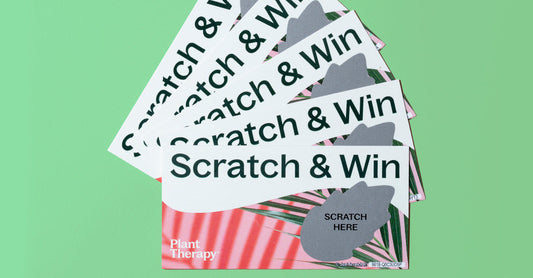I don’t know about where you live, but here in Southern Idaho, the beautiful geranium plant is a pretty standard staple in many home gardens. Its dense umbels of colorful flowers and fuzzy, serrated, heart-shaped leaves not only make a beautiful statement—they smell amazing.

Interestingly, there are hundreds of different species of the Pelargonium genus (which is the fancy way to say “geranium plant”), but only a few of those produce essential oils. Here, we’re going to talk about Geranium Egyptian (Pelargonium x asperum), which is sourced directly from—you guessed it—Egypt, and is one of two varieties of Geranium EO sold here at Plant Therapy.
So if you have a bottle, are thinking about buying a bottle, or don’t even realize you want a bottle (yet!), let’s go over some really easy and practical ways to bring Geranium Egyptian into your life.
Add Geranium Egyptian to your cart
1. A girl’s best friend during that time…

Move over diamonds, there’s a new bestie in town! And unlike that beautiful bling, Geranium has some real practical uses for a girl in need. Hailed for being a gentle bringer of grace and harmony, this essential oil really steps up to the plate when those uncomfortable womanly symptoms arise.
For menstrual cramps, simply dilute Geranium Egyptian in your favorite carrier oil and massage onto your abdomen. For a safe 3% dilution, all you need is 2 teaspoons of carrier oil and 9 drops of Geranium Egyptian. As this essential oil is well-known for its beneficial effects on women’s reproductive health, it can help soothe discomfort related to “that time of the month.” To use alongside another great essential oil for womanly concerns, Clary Sage, try blending 3 drops of each in two teaspoons of Evening Primrose Refined Carrier Oil (which also assists in comforting during these times) and massage onto the abdomen.
Women who are undergoing hormonal changes may also find relief in Geranium Egyptian. It has a fantastic balancing effect on emotions that are running wild! Plus, it can help you feel more stable during times of moodiness, helping to reduce feelings of irritability and nervous tension .
2. Stay calm and carry on!

For reasons too numerous to list, we all get stressed out sometimes. Whether work is exhausting you, responsibilities at home are piling up, or things in life aren’t lining up quite right for you, frayed nerves make everything worse. Let Geranium Egyptian be that friend whose shoulder is always ready for you to lean on! It helps to reduce those unpleasant feelings that can crop up when stress hits, and even start to lessen the impact of any consistent, unhappy thoughts .
Geranium Egyptian has an uplifting and fresh, sweet, green aroma that helps to ease tension built up from the stress of everyday life. It’s a great choice for enhancing positive feelings and promoting a sense of inner peace by lifting the spirits . Try diffusing alone or blend it with essential oils that are known to be grounding and calming, like Vetiver or Patchouli, to create a very relaxing environment that will help get you back to your best self.
To learn more about essential oils that can help with feelings associated with stress, visit 7 Essential Oils to Help with Anxiety, Stress, and Depression.
3. Sleep soundly.

As an essential oil that does wonders for nerves and tension associated with worry and stress, Geranium Egyptian can also promote restful sleep. Its balancing effect on the emotions will help to relax both your mind and your body, helping you get to sleep faster and stay asleep longer. Try adding a couple of drops right onto a cotton ball and placing near your bedside or tucking near your pillow before going to bed.
4. Enjoy healthy, glowing skin.

We can’t talk about Geranium Egyptian without gushing over how great it is for complexion! This skin-balancing oil is gentle enough to use on mature skin but tough enough to help with blemishes, dryness, and the appearance of wrinkles. It works to help balance the production of sebum, which is the natural oil that helps keep skin supple. This means that no matter your skin-type, Geranium Egyptian may be able to give you that glow you’ve always been searching for.
To help improve the overall skin complexion on your face, just take a teaspoon of your favorite skin-loving carrier oil, face wash, or lotion and add one single drop of Geranium Egyptian. Apply a pea-sized amount it to a clean face in the evenings. Love it enough to make a bigger batch? That’s great! Just please keep in mind our recommendation for a 1% dilution on the face.
And of course, we can’t forget about the skin that’s not on your face!

Geranium Egyptian is a popular essential oil to use for massage applications. It has a beautiful aroma that supports positive emotions. It is also grounding and can instantly help create feelings of calm and ease, boosting the stress-fighting power of a massage. We recommend a 2-4% dilution for topical application to help enhance the appearance of healthy skin and leave you feeling relaxed and uplifted.
New to dilution or just need a refresher? Check out our comprehensive guide to diluting essential oils HERE.
Want to learn more about the two Geranium EOs Plant Therapy offers? Read our blog Which Geranium Should You Choose?
Sources:
Purchon, N., & Cantele, L. (2014). The Complete Aromatherapy and Essential Oils Handbook for Everyday Wellness Paperback. Pg. 39.
Morris, N., Birtwistle, S., & Toms, M. (1995). Anxiety Reduction. International Journal of Aromatherapy 7, 2, 33-39. Perry, N. and Perry, E. (2006) Aromatherapy in the management of psychiatric disorders: clinical and neuropharmacological perspectives. CNS Drugs 20, 4, 257-280.
Perry, N., & Perry, E. (2006). Aromatherapy in the management of psychiatric disorders: clinical and neuropharmacological perspectives. CNS Drugs 20, 4, 257-280.
Harding, J. (2008). The essential oils handbook. Watkins: London.









